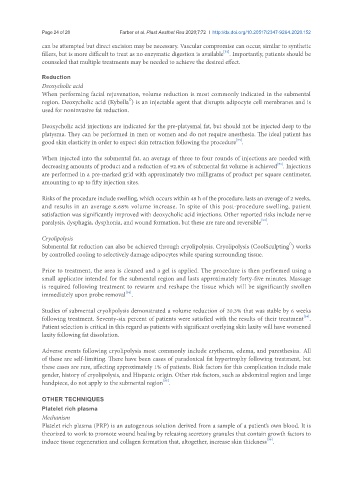Page 874 - Read Online
P. 874
Page 24 of 28 Farber et al. Plast Aesthet Res 2020;7:72 I http://dx.doi.org/10.20517/2347-9264.2020.152
can be attempted but direct excision may be necessary. Vascular compromise can occur, similar to synthetic
[52]
fillers, but is more difficult to treat as no enzymatic digestion is available . Importantly, patients should be
counseled that multiple treatments may be needed to achieve the desired effect.
Reduction
Deoxycholic acid
When performing facial rejuvenation, volume reduction is most commonly indicated in the submental
Ò
region. Deoxycholic acid (Kybella ) is an injectable agent that disrupts adipocyte cell membranes and is
used for noninvasive fat reduction.
Deoxycholic acid injections are indicated for the pre-platysmal fat, but should not be injected deep to the
platysma. They can be performed in men or women and do not require anesthesia. The ideal patient has
[53]
good skin elasticity in order to expect skin retraction following the procedure .
When injected into the submental fat, an average of three to four rounds of injections are needed with
decreasing amounts of product and a reduction of 92.8% of submental fat volume is achieved . Injections
[53]
are performed in a pre-marked grid with approximately two milligrams of product per square centimeter,
amounting to up to fifty injection sites.
Risks of the procedure include swelling, which occurs within 48 h of the procedure, lasts an average of 2 weeks,
and results in an average 8.68% volume increase. In spite of this post-procedure swelling, patient
satisfaction was significantly improved with deoxycholic acid injections. Other reported risks include nerve
[53]
paralysis, dysphagia, dysphonia, and wound formation, but these are rare and reversible .
Cryolipolysis
Submental fat reduction can also be achieved through cryolipolysis. Cryolipolysis (CoolSculpting ) works
Ò
by controlled cooling to selectively damage adipocytes while sparing surrounding tissue.
Prior to treatment, the area is cleaned and a gel is applied. The procedure is then performed using a
small applicator intended for the submental region and lasts approximately forty-five minutes. Massage
is required following treatment to rewarm and reshape the tissue which will be significantly swollen
immediately upon probe removal .
[54]
Studies of submental cryolipolysis demonstrated a volume reduction of 20.3% that was stable by 6 weeks
[54]
following treatment. Seventy-six percent of patients were satisfied with the results of their treatment .
Patient selection is critical in this regard as patients with significant overlying skin laxity will have worsened
laxity following fat dissolution.
Adverse events following cryolipolysis most commonly include erythema, edema, and paresthesias. All
of these are self-limiting. There have been cases of paradoxical fat hypertrophy following treatment, but
these cases are rare, affecting approximately 1% of patients. Risk factors for this complication include male
gender, history of cryolipolysis, and Hispanic origin. Other risk factors, such as abdominal region and large
[55]
handpiece, do not apply to the submental region .
OTHER TECHNIQUES
Platelet rich plasma
Mechanism
Platelet rich plasma (PRP) is an autogenous solution derived from a sample of a patient’s own blood. It is
theorized to work to promote wound healing by releasing secretory granules that contain growth factors to
[56]
induce tissue regeneration and collagen formation that, altogether, increase skin thickness .

